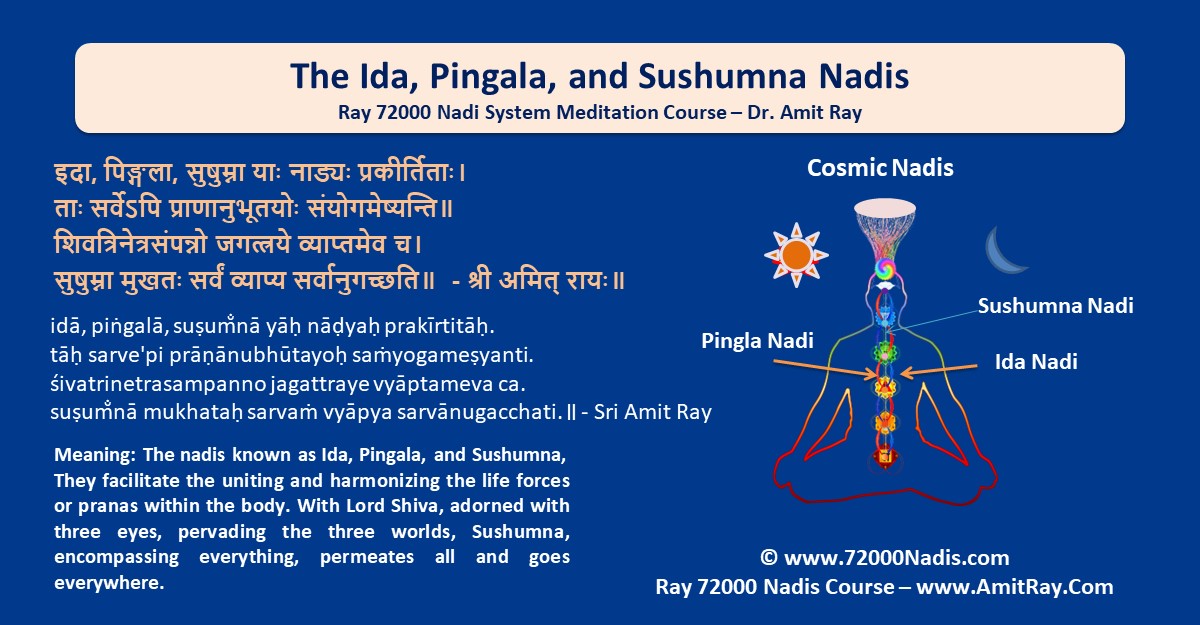Welcome to the fascinating world of nadis, and chakras! The interaction between nadis and chakras is like a cosmic dance, synchronizing our physical, mental, and emotional well-being. The human body is not just a physical entity but also an intricate system of energy channels known as nadis.
These nadis are responsible for the flow of vital life force energy, or prana, throughout the body. Among the numerous nadis, three major channels play a crucial role in maintaining balance and harmony within the body: Ida, Pingala, and Sushumna.
In this article, we’ll explore what nadis are, the details of the three primary nadis: ida, pingala, and the sushumna, and the significance of nadis in our total well-being.
What are the Nadis?
The term “nadi” originates from the Sanskrit language and refer to either “flow” or “channel.” Nadis are the energetic channels that run throughout our bodies and convey the prana, also known as the “life force energy.”
Imagine each nadi as a conduit, carrying the life force energy to specific areas of our body. These subsidiary nadis distribute prana to our muscles, organs, glands, and even the tiniest cells. They provide the vital energy required for every bodily function, from the beating of our hearts to the firing of neurons in our brains.
While the 72000 nadis serve distinct purposes, the three primary nadis play a central role. Ida, the lunar channel, represents the nurturing, calming, and receptive energy. It courses along the left side of our body, cooling and soothing as it flows.
Pingala, the solar channel, embodies fiery, dynamic, and action-oriented energy. It travels along the right side, igniting passion and vitality within us.
The Sushumna Nadi, the grand central channel, lies at the core of our being, connecting the base of our spine to the crown of our head. It acts as the pathway for spiritual evolution and higher states of consciousness.
The 72000 Nadis Network:
Now, you may wonder, how do these nadis manifest and what purpose do they serve? The primary nadis—Ida, Pingala, and Sushumna—act as the major channels, while the remaining 72,000 are subsidiary pathways that branch out like tributaries from a mighty river. Together, they create a comprehensive network, ensuring the harmonious flow of prana throughout our entire being.
You may picture it as a sophisticated highway system within our bodies, but instead of cars, we have an intricate network of energy pathways. Just as cars traverse highways to reach their destinations, our prana flows through these nadis, nourishing every aspect of our being. Appreciate the intricate design, the interconnections, and the harmonious flow of energy as you navigate the energetic landscape within.

Blockages in the Nadi System
Sometimes, the energy pathways encounter blockages or imbalances, hindering the smooth flow of prana. In such cases, the nadis can find alternative routes, much like bypass roads on a highway system. These energetic detours create new pathways, circumventing any obstructions and allowing the vital life force energy to reach its intended destination. These pranic bypasses ensure that energy flows unhindered, promoting overall well-being and restoring energetic balance.
The Three Primary Nadis: Ida, Pingala, and Sushumna

The human body has three main energy pathways called nadis: Ida, Pingala, and Sushumna. In this section, we discussed the details of these three primary nadis. By understanding and working with these three nadis, you can find balance, vitality, and inner harmony in your life.
1. Ida Nadi: The Path of Serenity and Intuition
Ida, known as the “moon” channel, is associated with feminine energy, the left side of the body, and qualities such as calmness, nourishment, intuition, and introspection. It originates from the base of the spine, intertwines with the chakras, and ascends along the left side of the Sushumna nadi. Finally, it terminates in the left nostril, influencing the energy flow on the right side of the body.
Ida represents the yin aspect of our being and affects the parasympathetic nervous system. Activating the Ida nadi promotes relaxation, emotional stability, and a cooling effect on the body and mind. By engaging in practices that stimulate the Ida nadi, such as gentle, meditative yoga postures and lunar pranayama (breathing techniques), you can restore balance, reduce stress, and cultivate a profound sense of tranquility.
2. Pingala Nadi: The Path of Vitality and Action
In contrast to Ida, Pingala is referred to as the “sun” channel and embodies masculine energy, the right side of the body, and qualities like dynamic action, vitality, and extroversion. Similar to Ida, it originates from the base of the spine, intertwines with the chakras, and ascends along the right side of the Sushumna nadi. Its journey culminates in the right nostril, influencing the energy flow on the left side of the body.
Pingala represents the yang aspect of our being and stimulates the sympathetic nervous system. Activating the Pingala nadi sparks physical energy, mental alertness, and a warming effect on the body and mind. Engaging in energizing practices like vigorous yoga asanas and solar pranayama can awaken the Pingala nadi, fostering vitality, focus, and an invigorating sense of well-being.
3. Sushumna Nadi: The Path to Spiritual Awakening
Sushumna, the central and most vital nadi, runs along the spinal column, intersects with the chakras, and connects the base of the spine to the crown of the head. It represents the path to spiritual awakening and self-realization. As the meeting point of Ida and Pingala nadis, Sushumna symbolizes the harmonious balance between the masculine and feminine energies within us.
Activating the Sushumna nadi leads to a state of union, where duality fades away, and a transcendent sense of oneness emerges. Various yogic practices, including pranayama, asanas, and meditation, aim to purify and awaken the Sushumna nadi, facilitating the upward movement of Kundalini energy and fostering spiritual growth.
The Nadis within the Sushumna nadi
Within the Sushumna nadi there are three nadis: Vajra Nadi, Chitra Nadi, and the Brahma Nadi. Vajra Nadi is associated with the qualities of strength, stability, and resilience. Chitra Nadi is related to the quality of clarity, insight, and higher perception. Brahma Nadi is with the awakening of higher consciousness and spiritual realization.
Colors of the Ida, Pingala, and Sushumna nadis
The colors associated with Ida, Pingala, and Sushumna nadis are symbolic representations and can vary in different traditions and interpretations. Here are some commonly mentioned color associations:
- Ida Nadi: White or blue color. It is often associated with the lunar or feminine energy, representing calmness, receptivity, and cooling qualities.
- Pingala Nadi: Red or orange color. It is often associated with the solar or masculine energy, representing activity, heat, and dynamic qualities.
- Sushumna Nadi: Transparent, Gold or bright yellow color. It is considered the central channel and represents the balance of both Ida and Pingala nadis. It signifies spiritual illumination, harmony, and the awakening of higher consciousness.
It’s important to note that these color associations may vary across different yoga and spiritual traditions. The colors are symbolic representations meant to convey the qualities and energies associated with these nadis rather than literal descriptions.
Harmonizing the Three Nadis:
The ultimate goal in yoga and spiritual practices is to balance and harmonize the flow of energy within the nadis, leading to a state of equilibrium and well-being. When the nadis are clear and balanced, prana flows freely, nourishing the physical body, mind, and spirit.
Through specific breathing techniques, pranayama, asanas, and meditation practices, yogis strive to purify and awaken the nadis, including Ida, Pingala, and Sushumna. By consciously working with these energetic pathways, one can restore the natural balance between the yin and yang aspects, enhance vitality, clarity, and intuition, and unlock higher levels of consciousness.
Awakening the Nadis and Unleashing Its Potential
While comprehending the intricacy of the 72,000 Nadis network may appear difficult, keep in mind that it represents the endless potential inside us. Like a thread in a tapestry, each nadi adds to the overall balance of our energy being. We may tap into our ultimate potential by nourishing and harmonizing this vast network, opening deep levels of awareness and connecting with the cosmic forces that surround us.
Final Thoughts
So, embrace the wonder of the 72,000 Nadis network inside you. Let us investigate the infinite possibilities of your energy existence. You may unveil the genuine core of your existence via attentive practices and a deep regard for this complicated network, overcoming constraints and embracing the magnificent adventure of self-discovery.
By consciously working with Ida, Pingala, and Sushumna nadis, you can unlock the extraordinary power within. Embrace the serenity and intuition of Ida, ignite the vitality and action of Pingala, and traverse the path of spiritual awakening through Sushumna. Engage in a holistic approach that encompasses pranayama, asanas, and meditation, tailored to balance and activate these energetic pathways.
As you harmonize the nadis, a profound transformation unfolds. Experience a renewed sense of balance, well-being, and empowerment on physical, mental, and spiritual levels. Embrace the journey of self-discovery and connect with your true essence, harnessing the immense power of Ida, Pingala, and Sushumna nadis to illuminate your path towards a fulfilling and awakened life.
